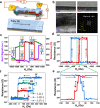Domain wall magnetic tunnel junction-based artificial synapses and neurons for all-spin neuromorphic hardware
- PMID: 38806482
- PMCID: PMC11133408
- DOI: 10.1038/s41467-024-48631-4
Domain wall magnetic tunnel junction-based artificial synapses and neurons for all-spin neuromorphic hardware
Abstract
We report a breakthrough in the hardware implementation of energy-efficient all-spin synapse and neuron devices for highly scalable integrated neuromorphic circuits. Our work demonstrates the successful execution of all-spin synapse and activation function generator using domain wall-magnetic tunnel junctions. By harnessing the synergistic effects of spin-orbit torque and interfacial Dzyaloshinskii-Moriya interaction in selectively etched spin-orbit coupling layers, we achieve a programmable multi-state synaptic device with high reliability. Our first-principles calculations confirm that the reduced atomic distance between 5d and 3d atoms enhances Dzyaloshinskii-Moriya interaction, leading to stable domain wall pinning. Our experimental results, supported by visualizing energy landscapes and theoretical simulations, validate the proposed mechanism. Furthermore, we demonstrate a spin-neuron with a sigmoidal activation function, enabling high operation frequency up to 20 MHz and low energy consumption of 508 fJ/operation. A neuron circuit design with a compact sigmoidal cell area and low power consumption is also presented, along with corroborated experimental implementation. Our findings highlight the great potential of domain wall-magnetic tunnel junctions in the development of all-spin neuromorphic computing hardware, offering exciting possibilities for energy-efficient and scalable neural network architectures.
© 2024. The Author(s).
Conflict of interest statement
The authors declare no competing interests.
Figures







References
-
- Ielmini D, Wong HSP. In-memory computing with resistive switching devices. Nat. Electron. 2018;1:333–343. doi: 10.1038/s41928-018-0092-2. - DOI
-
- Zhang W, et al. Neuro-inspired computing chips. Nat. Electron. 2020;3:371–382. doi: 10.1038/s41928-020-0435-7. - DOI
-
- Zhou J, Chen J. Prospect of spintronics in neuromorphic computing. Adv. Electron. Mater. 2021;7:2100465. doi: 10.1002/aelm.202100465. - DOI
Grants and funding
LinkOut - more resources
Full Text Sources

